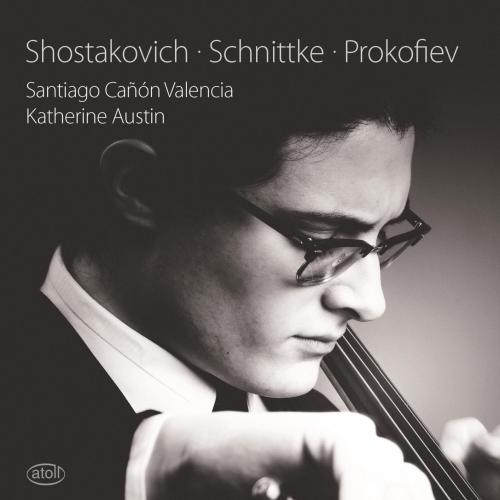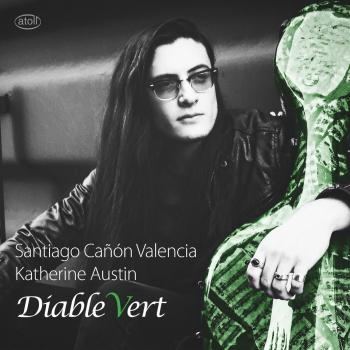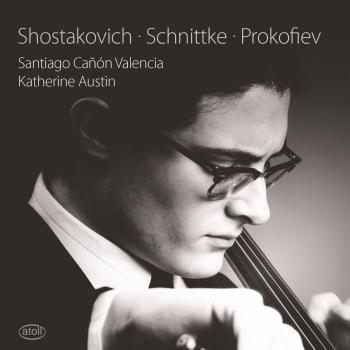
Shostakovich, Schnittke & Prokofiev: Cello Sonatas Santiago Cañón Valencia & Katherine Austin
Album Info
Album Veröffentlichung:
2019
HRA-Veröffentlichung:
17.05.2019
Label: Atoll
Genre: Classical
Subgenre: Chamber Music
Interpret: Santiago Cañón Valencia & Katherine Austin
Komponist: Dmitri Shostakovich (1906-1975), Alfred Schnittke (1934-1998), Sergej Prokofiev (1891-1953)
Das Album enthält Albumcover Booklet (PDF)
- Dmitri Shostakovich (1906 - 1975): Cello Sonata in D Minor, Op. 40:
- 1 Cello Sonata in D Minor, Op. 40: I. Allegro non troppo 12:20
- 2 Cello Sonata in D Minor, Op. 40: II. Allegro 03:04
- 3 Cello Sonata in D Minor, Op. 40: III. Largo 08:58
- 4 Cello Sonata in D Minor, Op. 40: IV. Allegro 04:40
- Alfred Schnittke (1934 - 1998): Cello Sonata No. 1:
- 5 Cello Sonata No. 1: I. Largo 04:00
- 6 Cello Sonata No. 1: II. Presto 06:39
- 7 Cello Sonata No. 1: III. Largo 11:55
- Sergei Prokofiev (1891 - 1953): Cello Sonata in C Major, Op. 119:
- 8 Cello Sonata in C Major, Op. 119: I. Andante grave - Molto animato 11:00
- 9 Cello Sonata in C Major, Op. 119: II. Moderato 05:08
- 10 Cello Sonata in C Major, Op. 119: III. Allegro ma non troppo 08:25
Info zu Shostakovich, Schnittke & Prokofiev: Cello Sonatas
Born in Bogotá in 1995, Santiago Cañón Valencia has been praised as one of the most promising young cellists of his generation. His major musical mentors have been Henrik Zarzycki in Colombia and James Tennant in New Zealand. He began winning major prizes in International competitions from the age of 11 including the Carlos Prieto (2006), Adams (2009), Beijing (2010) Gisborne and Johansen (2012), and the Lynn Harrell and Pablo Casals (2014). He has performed as soloist and in recital throughout Australasia, the USA, South America, South Africa, Europe and Russia and has previously recorded a highly praised debut CD of solo 20th century works in 2012.
Currently Head of Piano at the Conservatorium of Music, University of Waikato, in Hamilton NZ, Katherine Austin was the winner of the inaugural New Zealand Young Musician of the Year competition and the NZ National Piano Award, both in 1982. Her principal mentors included Janetta McStay, Bryan Sayer and Irina Zaritskaya. She has performed as soloist in NZ with all the major orchestras including the NZSO and Auckland Philharmonia, and performs regularly in Europe, Australasia, China and the Americas as the pianist of the New Zealand Chamber Soloists and the Tennant-Austin Duo. Between 2008 and 2016 Katherine and Santiago have performed in over 100 concerts together.
Shostakovich composed the Sonata Op. 40 in 1934, a few months after the original version of his controversial Lady Macbeth of Mtsensk was produced in Leningrad. Stung by the cruel official disapproval of his "decadent" opera, Shostakovich practically abandoned stage and film composition, devoting himself to instrumental music. On Christmas day of that year he gave the first performance of the Sonata with his friend Viktor Kubatsky, cellist of the Stradivarius Quartet and Bolshoi Theatre, to whom the score is dedicated. The sonata consists of four movements. The first movement places the cello in a lyric role with a primarily secondary piano accompaniment. This movement is in sonata-allegro form; Shostakovich spends much time establishing each theme individually to create a clearer contrast between moods. The second movement's foot-stomping dance, with its ethereal glissandi in the cello's upper register, suggests a manic perpetual motion machine. The third movement, almost bordering in stasis, is perhaps one of the most introspective works in the cello repertoire. In the fourth movement, there is a return to the irony and sarcasm, focusing on music that is grotesque and irreverent.
Alfred Schnittke dedicated this sonata to the famous cellist Natalia Gutman. The three movements are set in a somewhat non-conventional form: Largo - Presto - Largo. The opening Largo is melancholic in character, rotating around C minor but always evading a resolution. Schnittke continues to explore major/minor changes in the furious Presto. Meticulously constructed on contrapuntal lines, this movement shows many different characters: wild chromatic thirds, threatening bass quavers on the piano, glissando fifths on the cello and the climatic arm cluster on the piano. The last movement uses much of the material of the previous movements manipulated through imaginative processes of augmentation and repetition.
Prokofiev composed his Cello Sonata for Mstislav Rostropovich, who gave the first performance in 1950, with no less than Sviatoslav Richter at the piano. The pianist tells the story of performing the newly written work for two different judging panels, apparently for authorisation to perform it in public. Even though much of Prokofiev's music was banned because of accusations of formalism as defined by the Zhdanov Decree only a year before the cello sonata was written, there was relatively little official opposition to this sonata, as it is principally a lyrical work with little of the harmonic daring associated with the younger Prokofiev. The first movement is a fine example of Prokofiev's gift for melody, with an amusing passage where the two instruments imitate each other, and a poignant, chiming close. The wittily ironic second movement scherzo has an even more lyrical interlude and the energetic finale has an extremely dramatic finish all very much set in the key of C Major, some might say as a form of mockery directed at the traditionalist government.
"The first disc of sonatas features the mighty Russian troika of Shostakovich, Schnittke and Prokofiev and how well Valencia and Austin ignite those very Slavic passions, never far below the surface in these works. With Shostakovich's 1934 Sonata, the pair extracts extraordinary colours from a compulsively dancing Allegro and, in a soul-searching Largo, find the stoic melancholy that the politically harassed composer portrayed so well. A gripping 1949 Sonata by Prokofiev, balancing acerbic wit with lyrical poignancy, reveals yet another composer doomed to play cat-and-mouse games with intransigent Soviet authorities. Schnittke could be more daring. Valencia teases us into his 1978 sonata with a long, beautifully sustained solo, caught to the last rustle of bow by the expert studio team of producer Wayne Laird and engineer Steve Garden." - William Dart, NZ Herald, April 2016.
Santiago Canon Valencia, cello
Katherine Austin, piano
Keine Biografie vorhanden.
Booklet für Shostakovich, Schnittke & Prokofiev: Cello Sonatas












